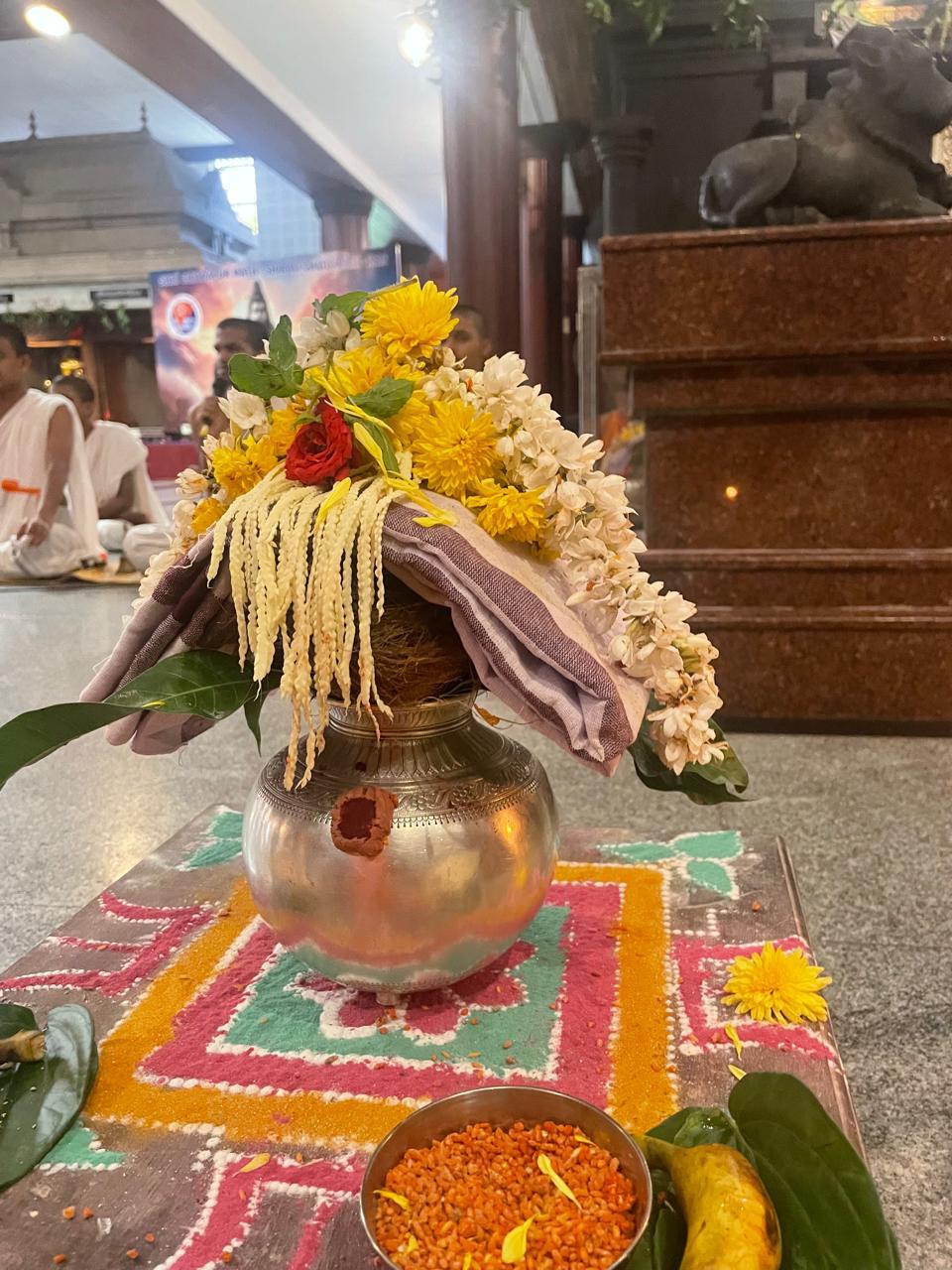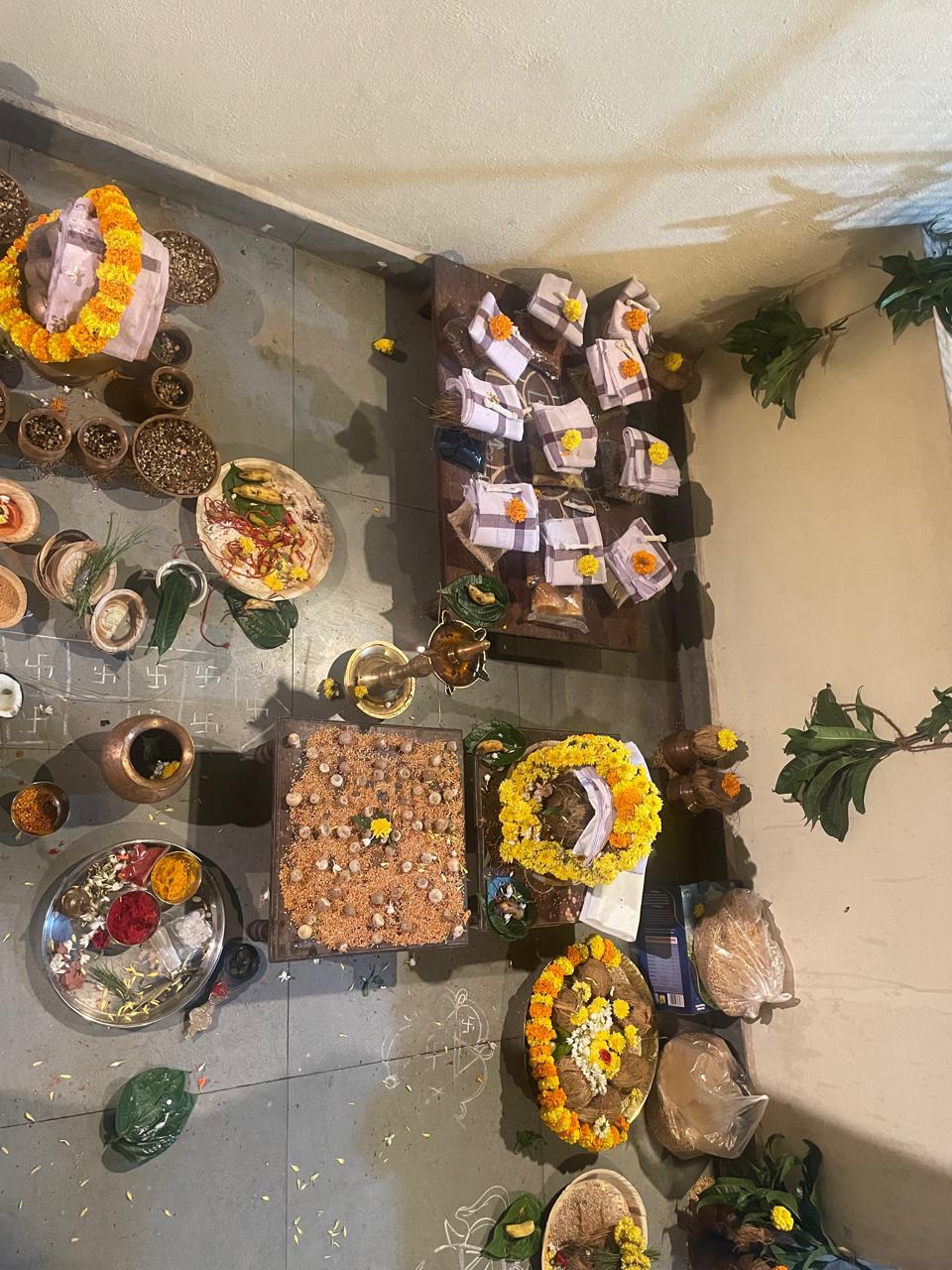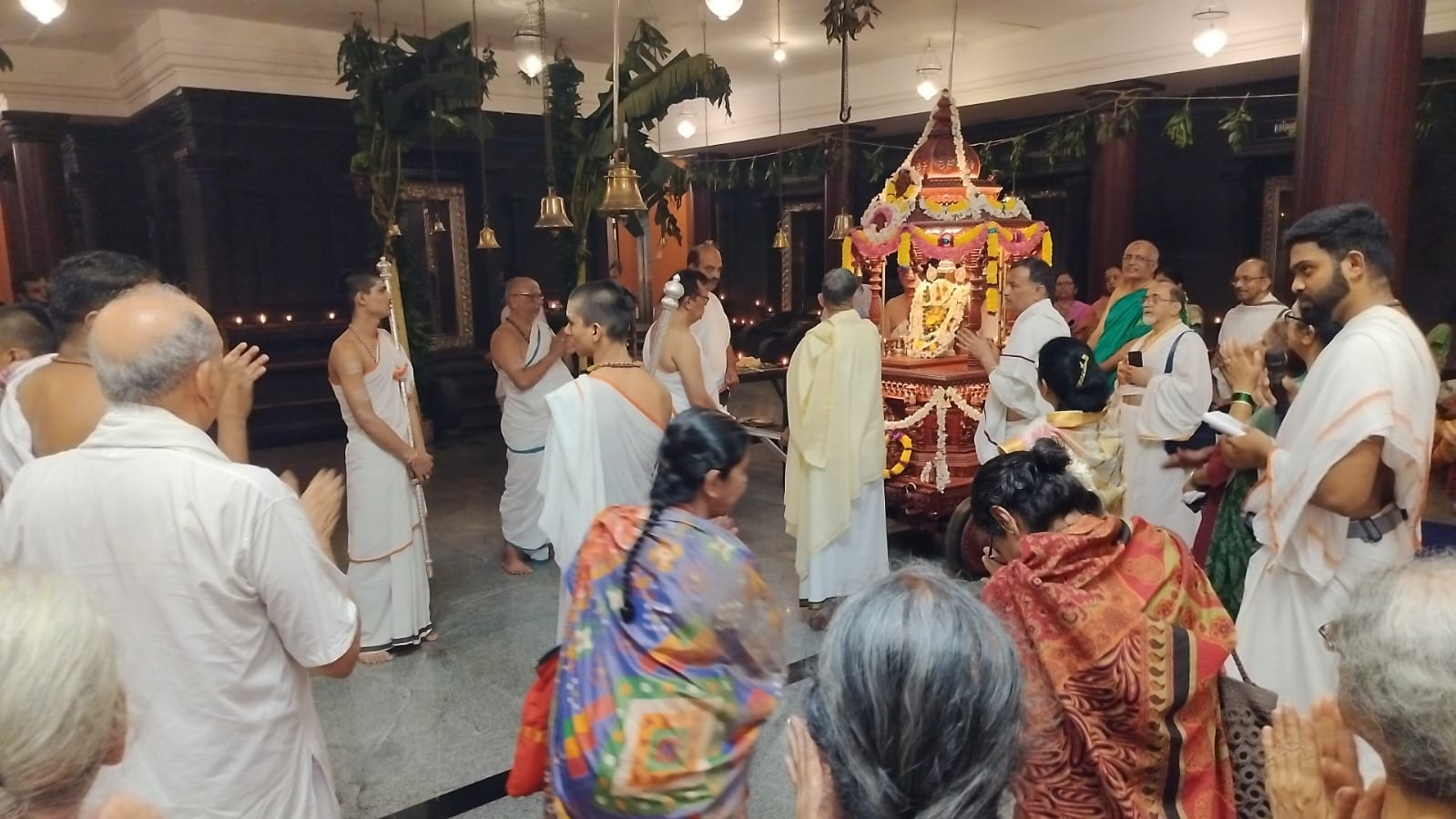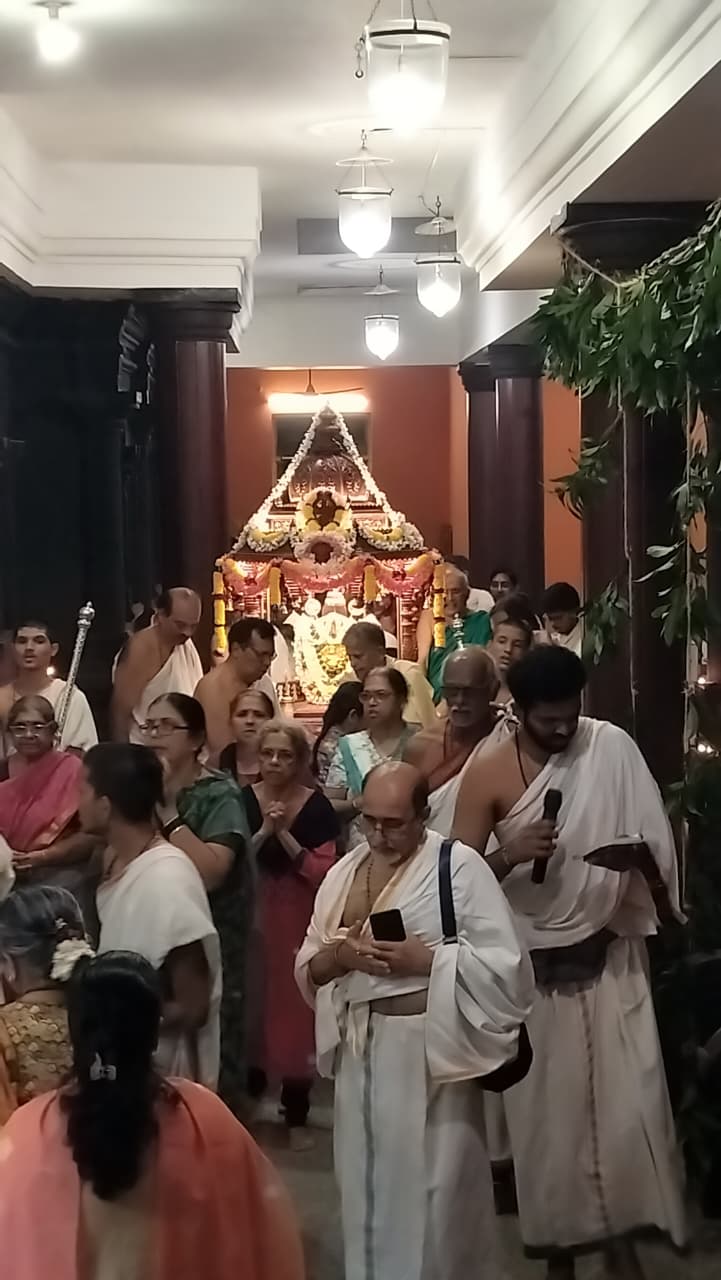MAHARUDRA
By Nandita Madhav with inputs from Chitrapur Sunbeam, Ved. Ul̃maṇ Guru Bhaṭmām, Ved. Nāgesh Hal̃dīpur Bhaṭmām,
Mahārudra is a sacred Vedic ritual performed to invoke the blessings of Lord Shiva and seek His divine grace and protection. The word “Mahā” means “great,” while “Rudram” refers to the chanting of the sacred Rudra—a powerful set of Vedic hymns dedicated to Lord Shiva. Considered highly auspicious, this elaborate ritual involves the chanting of the Rudra 1,331 times by a group of learned priests over several days. This chanting purifies the surroundings, brings peace, prosperity and overall well-being, strengthening the devotee’s bond with Lord Shiva. The chanting of Rudram is regarded as an act of devotion and gratitude, and is offered with deep reverence to the Lord. Mahārudra, is often performed on special occasions, during major religious festivals, or at significant astrological alignments to enhance its spiritual benefits.
Mahārudra is an important form of Rudra-worship in the Chitrāpur Sāraswat tradition. Here are some key aspects of Rudra-worship:
Chanting of the Rudram mantra-s is called Rudra Pat͟hana or Rudrādhyāya Pat͟hana. This chanting is named differently, as given below, depending upon the number of times the mantra-s are chanted.
Ekādasha-Rudra: The basic form where Rudrānuvāka is chanted 11 times
Laghu-Rudra: Consists of 11 Ekādasha -Rudra (11 x 11 Āvartana-s = 121 cycles)
Mahā-Rudra: Consists of 11 Laghu-Rudras (11 x 11 x 11 Āvartana-s = 1331 cycles)
Ati-Rudra: An even higher form of the ritual, and is the highest level of Rudra-worship. This is equivalent to performing 11 Mahārudra-s. (11 x 11 x 11 x 11 Āvartana-s = 14641 cycles)
Ritual Components:

The Mahārudra Sevā at Shrī Chitrāpur Mat͟h, Shirālī begins with the auspicious Kalasha Sthāpanā on the inaugural day. This sacred installation is performed with a Prārthanā in front of the revered Hoḍi Samādhi, invoking the blessings of Lord Bhavānīshaṅkar and our Revered Guruparamparā. This is followed by a Prāyashchitta Homa.
From the following day, the daily Rudra Pārāyaṇa commences. Each day begins with the chanting of the Rudram, offered with the traditional Bilvārchanā to Lord Bhavānīshaṅkar. After this, the Kalasha Pūjā is performed, wherein the consecrated Kalasha-s are worshipped with Vedic mantra-s. This is followed by the Āvartana-s—systematic chanting of the Rudram by Vaidika-s, due to which the atmosphere of the Mat͟h resonates with the sacred vibrations of the Veda-s.

The Rudrānuvāka itself consists of two parts:
The Namaka is a profound collection of sacred mantra-s and forms the first part of the Rudrānuvāka, structured into eleven sections (anuvāka-s). It is characterized by the constant refrain of "namaḥ" (salutation) and is considered a form of mystical poetry expressing pure God-intoxication. Among its sections, the eighth holds special significance, containing six particularly potent mantra-s that capture the essence of devotion to Lord Shiva. These sacred verses include "Shāmbhavāya namaḥ" (salutations to Him who is Bliss incarnate), "Mayobhavāya namaḥ" (salutations to Him who is delightful), "Shaṅkarāya namaḥ" (salutations to Him who brings about Bliss), "Mayaskarāya namaḥ" (salutations to Him who delights us), "Shivāya namaḥ" (salutations to Him who is peaceful and auspicious), and "Shivatarāya namaḥ" (salutations to Him who is ever more peaceful and auspicious).
The Chamaka, which follows the Namaka in the ritual sequence, represents an elaborate system of petitionary prayers marked by the recurring phrase च मे (give me). Also comprising of eleven sections, each portion presents a detailed collection of prayers that reflects the comprehensive vision of our Vedic seers. The prayers encompass requests for spiritual values such as truth (Satyam), righteousness (Ṛtam), dharma, and courage (Dhṛti),and, at the same time, addressing worldly and environmental concerns. Notably, the fifth section is dedicated to environmental preservation, the tenth section presents an intricate classification of cattle, and the eleventh section explores spiritual symbolism through numbers. What distinguishes the Chamaka is that its prayers are not meant for personal gain but are offered in the spirit of Yajña, seeking blessings to benefit one and all. This sequence of first offering salutations (Namaka) before making requests (Chamaka) follows the traditional principle of spiritual practice.
During this divine observance, the Shiva Liṅga is reverently bathed with a sequence of auspicious offerings including milk, curds, ghee, honey, sugar-cane juice, mango juice, jaggery solution, and finally, coconut water or pure water, each accompanied by precise māntric recitations. The sanctity of the ritual is further enhanced through the scholarly discourses on Rudra, Rudrābhis͟heka, and the intricate meanings of the Rudra Namaka and Chamaka mantra-s. Often culminating in the Sahasra Kalasha Abhis͟heka - an Āgamic rite that serves to restore and replenish Divine Energy - this sacred ceremony is believed to bestow the choicest blessings of Lord Bhavānīshaṅkar while cleansing the devotees of all sins.

On the concluding day of the Mahārudra Sevā, a Shrī Pus͟hpa Ratha Sevā is offered. It is verily an Utsava by itself. It is centered around a Pus͟hpa Ratha which was donated during H.H. Shrīmat Sadyojāt Shaṅkarāshram Swāmījī’s S͟has͟hṭyabdapūrti celebrations and is a sacred offering of devotion to Lord Bhavānīshaṅkar. In earlier times, a Pālkī Utsava was held on the fifth day. This beautiful tradition, with the participation of the Yajamāna and his family, carries forward the spirit of sevā and surrender. The Deity is taken in the Pus͟hpa Ratha in seven rounds of the sanctified inner Parikramā—each accompanied by Vedic chants— which consist of chanting of Ṛgveda, Yajurveda, Saṅgīta, and playing of musical instruments which consist of Shaṅkha Vādya, Veṇu Vādya, Mauri Vādya, and Sarva Vādya, filling the atmosphere with divine vibrations. After the final round with Sarva Vādya sevā, the Lord is ceremonially taken back to the main shrine, after which the daily sacred As͟hṭāvadhāna Sevā begins.

May Lord Bhavānīshaṅkar’s boundless Grace guide us, protect us, and bless all beings with peace and well-being.
